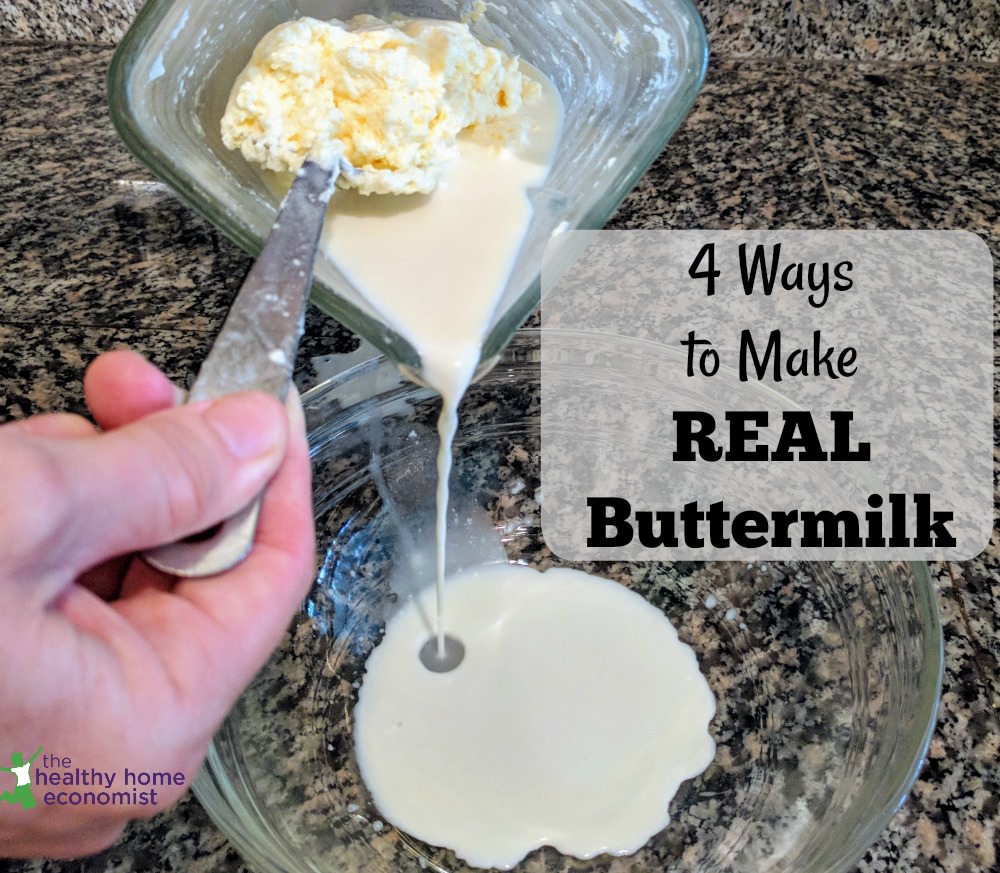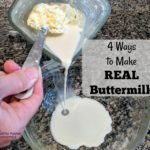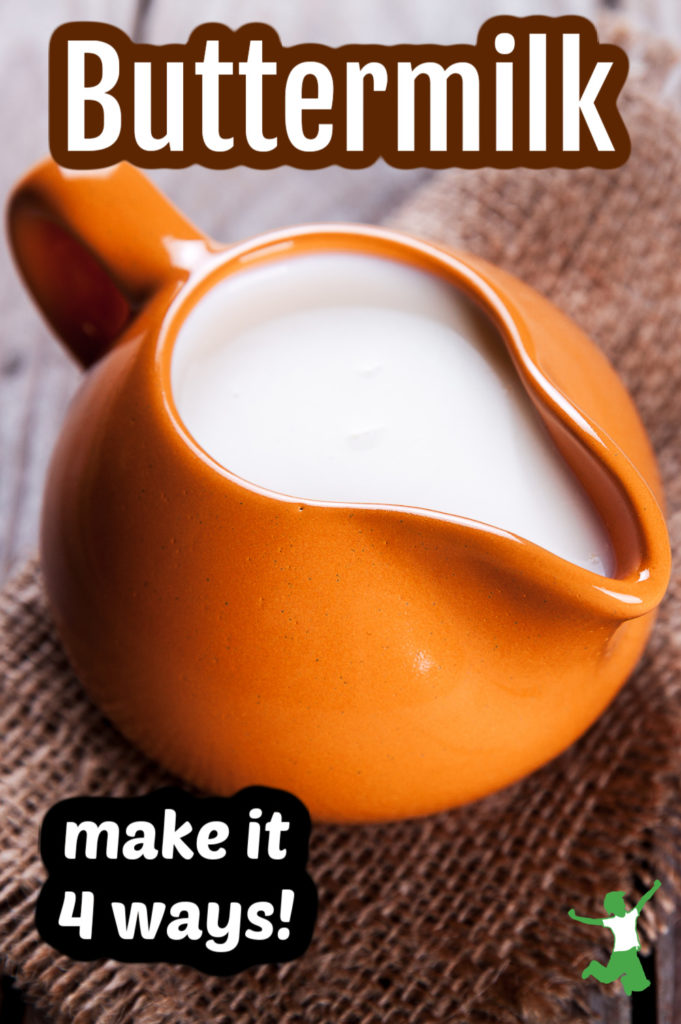Table of Contents[Hide][Show]
Four easy methods for making real buttermilk that is loaded with probiotics and enzymes to facilitate digestion with delicious, old fashioned taste.

My recent recipe for homemade quark resulted in a number of emails asking about how to make cultured buttermilk, a key ingredient in this German-style soft cheese.
I decided to devote an entire article to my response because, in my view, buttermilk is quite possibly the most confusing of all cultured dairy foods!
Traditional Cultured Buttermilk
In its true form, traditional buttermilk is a thin, milky, beige or even grayish colored liquid that is the by-product of churning slightly soured, probiotic-rich cream into butter. It is rich in beneficial lactic acid bacteria and enzymes, which is why people frequently enjoyed it as an effective natural remedy for indigestion. It also contains very low levels of lactose, and for this reason, is usually tolerated well by the lactose intolerant.
Most people have never seen this kind of real buttermilk, however! They are familiar primarily with the buttermilk from the supermarket made of pasteurized milk thickened with buttermilk powder and potentially other additives as well.
This factory produced buttermilk contains no probiotics or enzymes whatsoever. It also contains a lot of lactose. It might taste like buttermilk, but it isn’t really buttermilk at all.
Grassfed Buttermilk?
Even the grass-fed buttermilk you might find in some health food stores isn’t the real thing. One brand carried by Whole Foods lists these ingredients:
Organic Fat Free Milk, Organic Tapioca Starch, Organic Guar and Locust Bean Gum, Sea Salt, Cultures.
It’s nice that the ingredients are all organic, the pasteurized milk comes from grass-fed cows, and the product contains some probiotic cultures, but this isn’t real buttermilk!
The Many Ways to Make Homemade Cultured Buttermilk
Another reason buttermilk is so confusing is that there are a number of ways to make it.
Below is an overview of four different traditional methods. The last one is my favorite because it costs nothing and takes no extra time. The recipe at the end covers methods 1 and 2.
How to Make Buttermilk from Cream
- Unpasteurized cream that is slightly soured is naturally rich in enzymes and probiotics. Churning this type of cream (I use a blender or a hand mixer to make it very easy) produces raw butter along with small amounts of cultured buttermilk. You can see what the process looks like in this video recipe on how to make butter. The picture above shows me pouring the buttermilk into a bowl after churning the cream into butter with my blender.
- Buttermilk is best made with raw cream. However, if all you have is pasteurized cream, you can still make it (do not use ultra-pasteurized or UHT cream). This type of cream is void of any probiotics or enzymes due to high heat processing. Hence, uncultured butter and buttermilk are the results when you churn it. However, you can then add buttermilk starter culture and ferment this uncultured buttermilk into cultured buttermilk.
- Yet a third way to make cultured buttermilk is to make homemade cultured cream before churning it into cultured butter and buttermilk.
The Easiest Method
A final way to make homemade buttermilk is to simply buy a quart from a local raw dairy farm. It is usually quite inexpensive too since it is the by-product of making butter. Leave this raw, uncultured buttermilk on the counter for 1-2 days before refrigerating. This will allow it to naturally sour into cultured form.
Now you know that true buttermilk is the thin liquid leftover from churning cream into butter. It is not whole, low-fat, or nonfat milk with buttermilk powder and thickeners added. Neither is it milk cultured with buttermilk starter.
You can certainly make it this way if you like. In fact, most recipes on the internet suggest this method. However, it is not the real thing. In that case, the thickened buttermilk is more like a drinkable style yogurt or kefir.
Benefits of Real Cultured Buttermilk
After reading all of the above, you might wonder why bother making real buttermilk? Why not just ferment milk with buttermilk starter and be done with it? Is this modern method so bad after all? Why take the extra step of making real butter just to obtain the liquid that is leftover?
The reason is that one of the huge benefits of real buttermilk is that it contains little to no lactose. For this reason, traditional buttermilk is an excellent fermented beverage for lactose intolerant people to obtain dairy calcium without adverse effects. (1)
Using commercial buttermilk from the store or making it out of milk instead of cream results in a lactose-rich, high carb buttermilk.
Real Buttermilk is Low Carb, Fake Buttermilk is High Carb
Besides being very low in lactose, real cultured buttermilk is also low carb. This compares to high carb commercial buttermilk made from milk.
For example, one pint of heavy grass-fed cream churned into butter yields approximately a half pound of butter plus 1 cup of buttermilk. This buttermilk is very low in carbohydrates with one serving containing <1 carb. (2)
Contrast this with one cup of whole milk with added buttermilk powder and thickeners. This buttermilk is high in carbohydrates, containing roughly 12 grams per cup! (3)
Thus, real buttermilk is more keto diet friendly than modern buttermilk.
How to Use
It is important to note that buttermilk should be cultured in order for it to be acidic enough (from the beneficial lactic acid bacteria) to be used for soaking flour for pancakes, soaked waffles, soaked bread and so forth.
As mentioned earlier, cultured buttermilk is also an important ingredient for making homemade quark, a German-style dairy food similar in texture to Greek yogurt.
Buttermilk also should be cultured when used as a natural remedy for indigestion or sour stomach.

Homemade Traditional Buttermilk (Low Carb, Probiotic Rich)
Easy blender method for making buttermilk out of heavy whipping cream. One pint of cream produces a half pound of butter and one cup of plain or cultured buttermilk.
Ingredients
- 1 pint heavy whipping cream preferably raw and grass-fed
- 1 buttermilk starter not needed if using raw cream
Equipment
- 1 blender or food processor
Instructions
-
Pour cream into the blender or food processor. Secure the lid firmly.
-
Turn on low and let the cream churn for 5-10 minutes. If your cream is very fresh and cold, it will take longer to whip into butter.
-
Once you can see the separation of butter from buttermilk is complete, turn off the blender and carefully pour the buttermilk into a bowl. If you use a fine mesh cheesecloth, you will separate out all the small bits of butter as well.
-
If you want cultured buttermilk and you used raw cream, leave the strained buttermilk on the counter in a sealed mason jar for 1-2 days. It will naturally ferment into cultured buttermilk.
-
If you used pasteurized cream, add buttermilk starter and use as directed.
-
You will end up with about 1 cup of butter and 1 cup of buttermilk.
Recipe Notes
Do not use UHT ultrapasteurized cream even if organic. It is denatured for excessively high heat processing and sometimes even contains unnatural thickeners.
This article on UHT milk explains more.









Leave a Reply